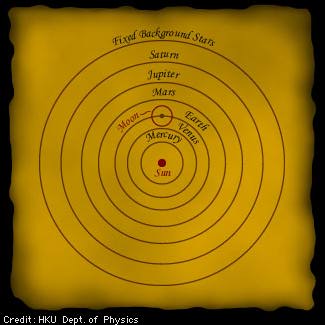
He is THE MAN -- Galileo Galilei!!
Galileo Galilei (pronunciation: ga-li- LAY-oh gal-li-LAY-ee) (1564–1642).
Italian scientist and mathematician who made several extraordinarily important discoveries. Almost all of which, incidentally, proved that Aristotle—for all his fame and brilliance and everything—was sort of an idiot.
The Basics
Galileo’s first significant contribution to science traditionally is said to have occurred atop the Leaning Tower of Pisa, when he supposedly dropped bodies (as in objects, not dead people) and proved that the speed of a falling object is not proportional to its weight, as Aristotle claimed. Before Galileo, everyone believed Aristotle, because—hey—he was Aristotle. (In reality, Galileo’s experiment probably involved rolling objects down an incline, not dropping them off a tower, but that’s not as good a story.) Galileo further contradicted Aristotle by proving that projectiles take parabolic trajectories (you’d think someone would have noticed this with all the catapulting that went on in the Middle Ages, but no).
Galileo was a pious and unassuming fellow who never sought to court controversy. But for some reason, he kept discovering things that disproved conventional wisdom. Fortunately, debunking Aristotelian physics never got anybody excommunicated from the Catholic Church. Unfortunately, Galileo started meddling in astronomy. At first, it seemed his observations made him rich and secured his fame. Having discovered four moons around Jupiter, he smartly named them after the ruling Medici family, who responded in kind by getting him a sweet gig in his native Tuscany.
But he soon noticed that Venus revolved around the Sun, which flew in the face not only of Aristotle’s beliefs, but also those of the Catholic Church. After keeping quiet on the issue for nearly a decade, Galileo received permission from the pope to write a book on the topic. The resulting work, succinctly titled Dialogue Concerning the Two Chief World Systems, Ptolemaic and Copernican, in which a character named Salviati explains that the earth clearly revolves around the Sun, and a guy aptly named Simplicio is constantly ridiculed for his irrational belief in an earth-centric universe.
Summoned to Rome for an Inquisition, Galileo eventually apologized (legend has it that at the end of his apology, he mumbled, “And yet—it moves,”) and was sentenced to life in prison. The “prison” proved to be a small, comfortable villa near Florence, where he continued to work, albeit with his heart broken by the Church to which he remained ever faithful.
Heliocentrism

Galileo was neither the first nor the only scientist to believe in a heliocentric universe. The idea was first put forth by Nicolaus Copernicus, who didn’t publish his work for decades and then had the good sense to die just after it finally saw the light of day, before anyone could get mad at him.
Galileo and the Scientific Method
So how come no one ever dropped a couple rocks from a cliff to check and make sure that Aristotle was right about the behavior of falling objects? Because until that point no one had invented the Scientific Method (aka the cornerstone of all modern science), wherein a hypothesis is developed and tested. Galileo’s credit for developing the Method, however, must be shared with Sir Francis “Don’t Call Me Sausage” Bacon. Between the two of them, they revolutionized the manner in which people approached the questions of the heavens.
Darn!! He is the guy behind all these??
IT’S A MATH, MATH, MATH, MATH WORLD
Although Galileo didn’t devote much time to the study of pure mathematics, he did make a discovery that baffled mathematicians for 250 years: He proved that there are as many perfect squares (1, 4, 9, 16, 25, etc.) as there are whole numbers (1, 2, 3, 4, 5, etc.), even though the vast majority of whole numbers are not perfect squares. Known as “Galileo’s Paradox of the Infinite,” this caused headaches for abstract mathematicians until the early 20th century, when Georg Cantor invented set theory, which has been causing headaches for Calculus II students ever since.
He must be very very free to do such maths!! Insanity!!
Conversation Starters
◆ In 1609, Galileo learned that a telescope had been invented by Hans Lippershey in the Netherlands. Unable to procure one from the inventor, he jerry-rigged his own contraption using three lenses he purchased at an eyeglass store. Then, with a little trial and error, Galileo eventually learned the fine art of grinding lenses—producing the most powerful telescope in the world. Aside from allowing him to chart the universe, his high-powered spyglass also proved definitively that the moon’s surface was not smooth, as scientists had previously thought, nor was it made of Swiss cheese, as scientists had secretly hoped.
◆ Like a lot of successful people, Galileo was a college dropout. He briefly attended the University of Pisa, but had to leave because he couldn’t afford tuition. Just a couple years later, however, he ended up returning to college—this time as a professor.
Almost like Bill Gates, Steve Job, who else? Millionaire?
◆ Galileo was also a prodigious inventor: Besides his work with the telescope, he invented the first compound microscope, a complicated air-and-water-based thermometer, and the first driver for a pendulum clock. (Among the inventions he sketched but never got around to making are a comb that doubled as an eating utensil, an automated tomato picker, and a ballpoint pen.)
Innovative inventer huh??
No comments:
Post a Comment